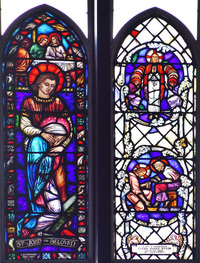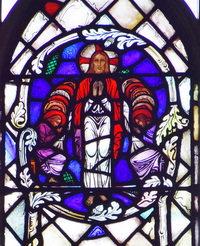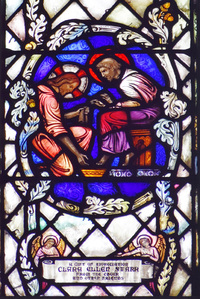Window
Building Name: St. John's Episcopal ChurchStudio Name: Willet Hauser Architectural Glass
City: Royal Oak
Window Shape: 5 (gothic arched, 2 vertical sections)
Date of Window: 1942
Subject/Title of Window: John the Beloved; Intercessionary Prayer at the Last Supper
Brief Description of Subject: This window was designed for this parish's Gothic styled Church which opened in 1926. Subsequently the congregation needed a larger church and replaced it with a modern styled church which opened in 1957, moving the stained glass to the new church. This window is now located on the second level of the Epistle side transept.
In the old Church each lancet was an individual window, however in its move to the new Church, they were combined to form one window.
Left Lancet: This lancet, featuring John the Beloved, was located in the old Church of St. John's in a place of importance --- just to the right of the altar. Its border is made up of geometrical patterns alternating with animals and boats. The large scene is based on John 19:26 - 27 --- as Jesus was dying on the cross, "when he saw his mother there, and the disciple whom he loved standing by, he said to his mother, 'Dear woman, here is your son,' and to the disciple, 'Here is your mother.' From this time on, this disciple took her into his home," (NIV). The scene depicts John, beardless as is customary, consoling a distraught Virgin Mary witnessing the coming death of her son. Above John's head is a scene taken from the Last Supper. John, seated next to Jesus (John 13:23), is pictured leaning against Jesus who is holding a piece of bread in his left hand, instituting the Holy Eucharist --- "He took bread, gave thanks and gave it to them, saying, 'This is my body,'" Luke 22:19 (NIV).
According to Church records this lancet was given in memory of Charles W. Steinhilber by his wife and son, Mrs Charles W. Steinhilber and Robert G. Steinhilber and dedicated on Palm Sunday, March 30, 1942.
Right Lancet: This medallion type lancet features two scenes from the Last Supper as written in the Gospel of John. Each scene is surrounded by oak leaves and acorns, symbolizing strong Faith.
The bottom scene is based on the story of "Jesus Washing His Disciples' Feet," which is found in John 13:1 - 20 --- "... he got up from the meal, took off his outer clothing, and wrapped a towel around his waist. After that, he poured water into a basin and began to wash his disciples' feet, drying them with a towel that was wrapped around him," Verse 4 - 5 (NIV). In the time of Christ, the roads were dusty and people wore sandals. It was customary, when guests entered a home, for a servant of the household to wash their feet. The Apostles did not understand why Jesus was washing their feet, this leads to Jesus' comment, "I tell you the truth, no servant is greater than the master, nor is a messenger greater than the one who sent him. Now that you know these things, you will be blessed if you do them," Verses 16 - 17 (NIV). The scene pictures Christ washing the feet of a reluctant Simon Peter (Verses 6 -11). The top scene pictures Christ giving the Intercessory Prayer at the Last Supper which takes up all of Chapter 17 of the Gospel of John. According to Church records, this lancet was given as a tribute to Clara Ellen Starr by members of the Choir and friends, and dedicated September 12, 1943.
Inscriptions: C.W. Steinhilber 1889-1940
A gift of Appreciation
Clara Ellen Starr
From the choir and other friends
Condition of Window: Good
Type of Glass and Technique: Lead Came
John the Beloved/Intercessionary Prayer at the Last Supper
The Intercessory Prayer at the Last Supper
Jesus Washing His Disciples' Feet
The MSGC is a constantly evolving database. Not all the data that has been collected by volunteers has been sorted and entered. Not every building has been completely documented.
All images in the Index are either born-digital photographs of windows or buildings or are scans of slides, prints, or other published sources. These images have been provided by volunteers and the quality of the material varies widely.
If you have any questions, additions or corrections, or think you can provide better images and are willing to share them, please contact donald20@msu.edu





